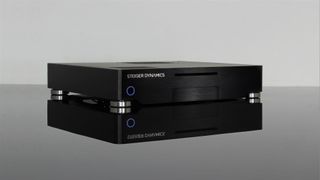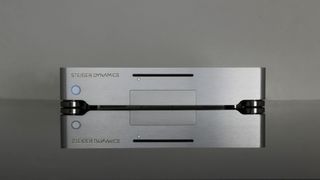Steiger's ERA HTPCs: Many Options For Three Models
CES is a hectic time, and even though we covered a lot during our week in Vegas, there were a few products that we just didn't have time to see. Steiger Dynamic's new lineup of ERA home theater PCs is one of the companies we missed, but its new line of living room PCs, called ERA, is worth mentioning, with small cases that can house a lot of power and performance for any living room system.
ERA comes in three different models -- Pure, Core and Reference -- with HWD measurements of 3.25 x 17.1 x 15.4 inches and weigh between 13 - 20 pounds depending on the user's configuration. The entire PC is encased in 4 mm of aluminum. According to Steiger, the Pure model has the power for a media center; Core is built for gaming; and Reference is the high-end, enthusiast model. However, customers don't have to stick with Steiger's recommendations since you can choose almost every component that goes into your ERA PC.

All three models have a mini-ITX form factor, but each one has a different chipset. The Pure carries an Intel H91 chipset, the Core has the H97, and the Reference has the Z97.
The base model Pure runs the Intel Pentium G3258 Anniversary Edition (dual-core, 3.2 GHz), but its most powerful processor option is the Intel Core i5 4590 (quad-core, 3.3 / 3.7 GHz Turbo), which is also the basic chip for the Core model. The Reference has the i5 4690K (3.5 / 3.9 GHz Turbo) to start. However, both Core and Reference models also support the Intel Core i7 4790 (quad-core, 3.6 / 4.0 GHz Turbo).
For memory, the Pure and Core have the same packages. Each starts with 4 GB (1 x 4 GB, 1600 MHz) of RAM but can be upgraded to 16 GB (2 x 8 GB, 1600 MHz). The Reference is in its own league by starting out with 8 GB (2 x 4 GB, 1866 MHz) and goes all the way to 16 GB (2 x 8 GB, 2133 MHz).
Graphics-wise, there's more than enough options so that you don't have to spend more than necessary for the graphics power needed for any situation. The Pure starts with integrated Intel HD Graphics, but you can choose from a range of other graphics cards all the way to an Nvidia GeForce GTX 980 Superclocked (4 GB). The Nvidia GeForce GTX 750 Ti Superclocked (2 GB) is the starting graphics card for Core, while Reference has the GTX 970 Superclocked (4 GB) in its basic package. For those who have a little more money to spend, you can upgrade both the Core and Reference models all the way to a Titan Z Superclocked (12 GB).
For storage, the ERA line offers multiple SSD and HDD options. Two SSDs can be placed in RAID configuration, but the ERA can also accommodate three 3.5" HDDs. Users can choose to not have any storage included in the purchase, but Steiger has a full stock of Western Digital HDDs between 1 TB and 6 TB as well as the 500 GB, 750 GB, and 1 TB versions of the Samsung 850 EVO SSDs.
Stay on the Cutting Edge
Join the experts who read Tom's Hardware for the inside track on enthusiast PC tech news — and have for over 25 years. We'll send breaking news and in-depth reviews of CPUs, GPUs, AI, maker hardware and more straight to your inbox.
Because these PCs are meant for the living room, keeping the noise to a minimum is paramount. Steiger hopes to solve that problem with multiple cooling options. The Pure and Core initially come with a stock Intel air cooler with a PWM fan and premium thermal compound. Reference also has the PWM fan and premium thermal compound, but it trades the stock Intel cooler with a larger aftermarket air cooler for its starting package.
You can opt for an even larger 140 mm cooler for both the Pure and Core models, and all three models can have a 140 mm case fan, too. However, it should be noted that Steiger Dynamics told us that the cooling solutions are still being finalized, meaning that each option's actual cooling performance -- and noise level -- is still up in the air.

As for ports, all three come with a wide variety for any home entertainment system. The front side features two USB 3.0 slots, an SDHD card reader, and HD audio in/out ports.
The back side has up to 10 slots for USB 3.0/2.0, optical S/PDIF, eight-channel audio jacks out, an audio jack in, HDMI, DVI, an Intel gigabit-ethernet port, and depending on the motherboard and graphics card, DisplayPort.
Pure and Core customers can also pick up an optional Bluetooth 4.0 USB dongle, a Netgear Wi-Fi 802.11ac USB dongle with an antenna (up to 1200 Mbps), and a Wi-Fi 802.11 b/g/n 2.4 GHz USB dongle with another antenna (up to 300 Mbps). In contrast, the Reference already includes an onboard ASUS Wi-Fi 802.11ac (2.4 / 5.0 GHz Turbo) with Bluetooth 4.0 LE with antennas (up to 867 Mbps).
When choosing a model, users can also pick between a custom version, where they pick all of the parts, or a stock option that has most of the parts already chosen, with room to change a few things. Pure's custom option starts at $899, with its stock option starting at $1,249. A custom build for the Core starts at $1,399, and the stock version will cost $1,999. The high-end Reference custom build costs $1,899 with the stock offering starting at $2,649.
The vast range of hardware options is impressive, and clearly, depending on how you configure a system, one of these rigs could function as a simple HTPC or a beastly gaming machine. For example, the ERA Pure starts out with a dual-core processor and integrated graphics. Those who have money growing on trees also have the luxury of picking up a Titan Z GPU and a Core i7 chip. The big issue here will be noise, especially when users start pushing the device to its limits with what's inside. Hopefully, the fan keeps up with the demand to give very minimal noise.
Steiger put the ERA under the category of home theater PCs, and you can see by the chassis style that it's meant for the living room. However, the vast array of options from graphics to connectivity shows that it goes beyond that category. Depending on the user, the ERA line has the ability to be a media device, a high-performance gaming system, and everything in between.
The fact that it's meant for a living room setting means that Steiger is following the trend of other companies at CES this year that are attempting to bring the PC experience out of the bedroom or basement. The price might be a little steep, but if you have the money and know what you want out of a living room PC, then Steiger just might be a good place to start.
Follow Rexly Peñaflorida II @Heirdeux. Follow us @tomshardware, on Facebook and on Google+.
-
azathoth The device looks very stylish, a Pentium G3258 + GTX 750Ti would make for a decent product if the price isn't absurd. (But we know, it will be $600+)Reply -
TechnoD If they sold just the case (no other components) they could probably make a fortune. that is a great looking caseReply -
nukemaster I am actually glad to see the optical drive slot.Reply
HTPCs should at least be able to play CD/DVD/BD. Even if you rip all your discs you may want to watch/listen one you just bought or a friend brings over.
Very slick looking case for sure. -
Haravikk Like others I'd buy the case in an instant, but for the price these units are very expensive for what you get; $1500 for an i3 using integrated graphics only? You could maybe argue $700 on the quality of the case and the upgradability, but I'm afraid they've priced these very poorly.Reply -
afrobacon Negating the size of the logo; I could easily spend upwards to $150 on this case based on aesthetics alone.Reply -
I love the case. If this didn't have an obnoxious logo on it, and came empty I would probably grab one. But let's face it, the case alone would probably be sold for over 500$, no way I would pay that much.Reply
Other designers should look at this and get inspired. I hate cases that have all these irregular indentations, trying to look cool or sci-fi like. It always end up looking cheap and toy-like.
My dream case: Same look, no optical slot, no cut rectangle at the bottom, no logo, space for 5 SSDs. -
Mr Black These cases look to be an OEM/ODM case from OriginAE.Reply
I agree, that steiger dynamics logo is just too big, and adds nothing to product.
Most Popular



